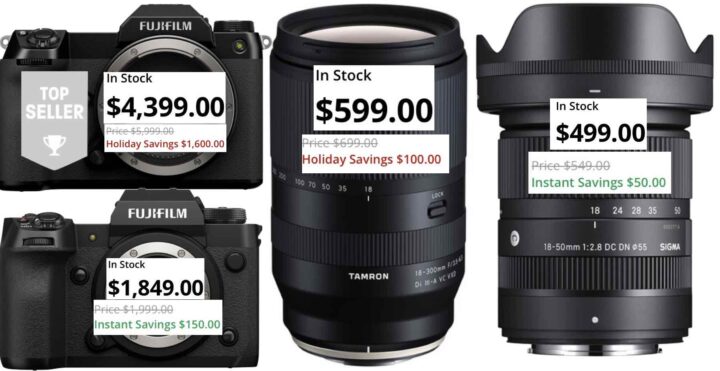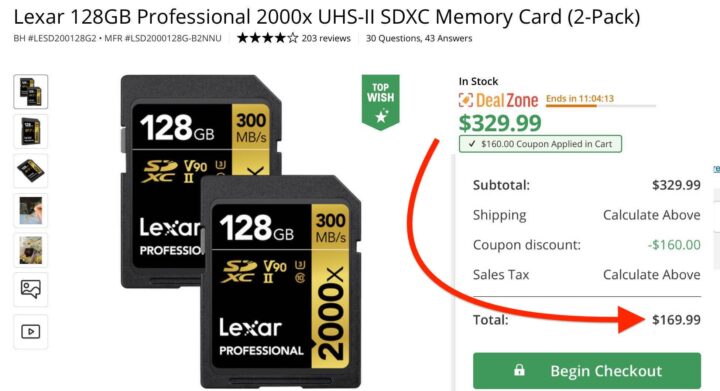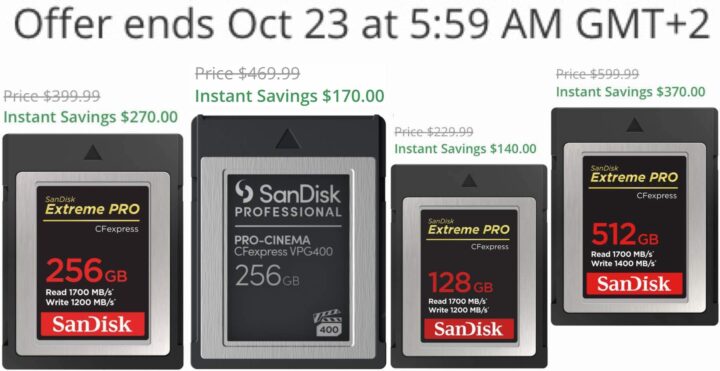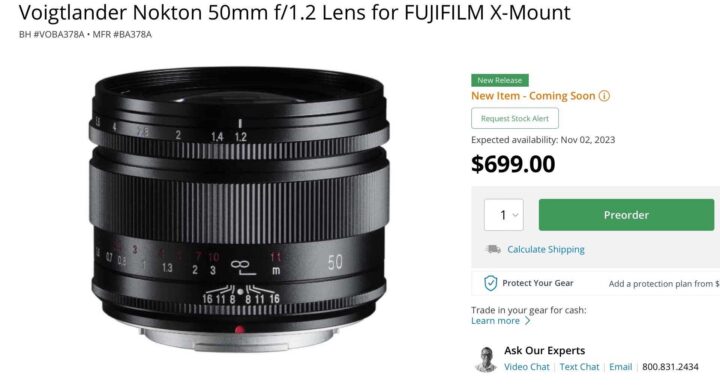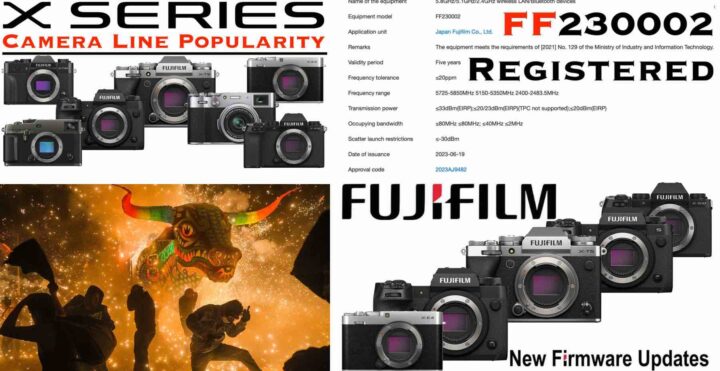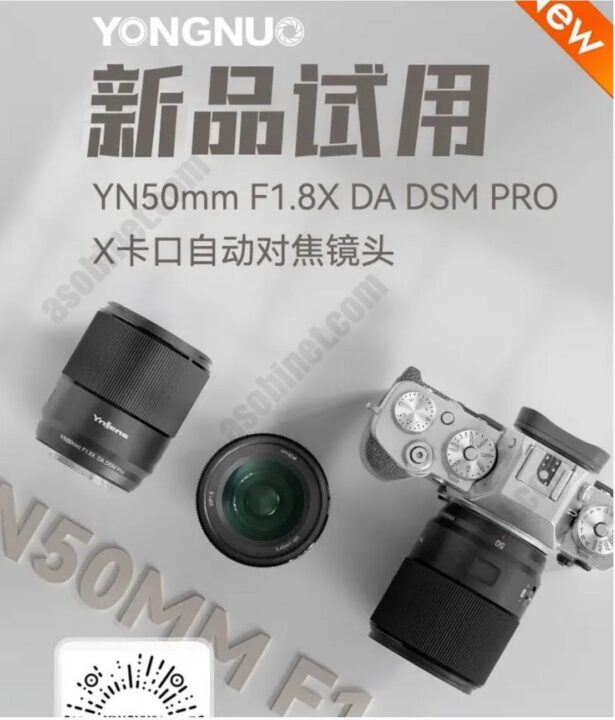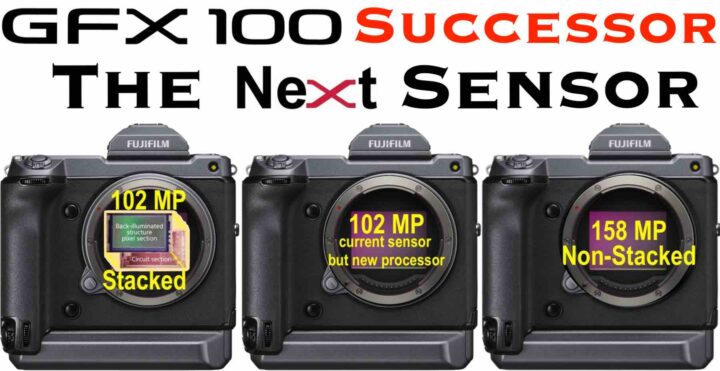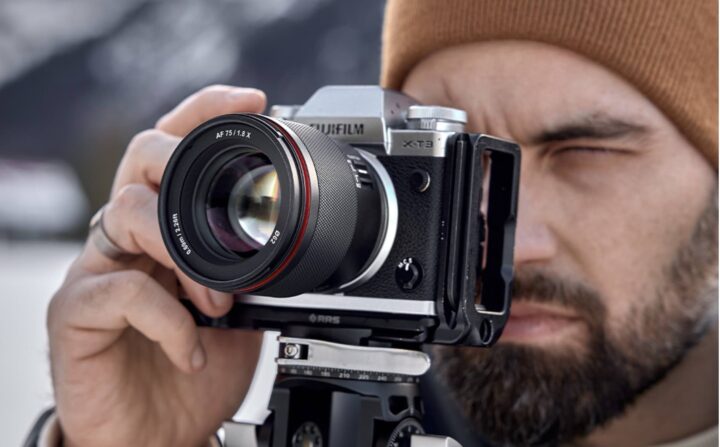Big Deals on Third Party AF X Mount Lenses, GFX100S, Lots of X/GFX Gear and More
Top Deals
- Fujifilm GFX100S –
save $800(save $1,600 until Dec.31)
BHphoto / AmazonUS / Adorama / Moment / Focuscamera - XF 150-600mmF5.6-8 – save $400
BHphoto / AmazonUS / Adorama / Moment - X-H2 – save $150
BHphoto / AmazonUS / Adorama / Moment - X-H2s – save $200
BHphoto / AmazonUS / Adorama / Moment - XF 50mmF1.0 R WR – save $300
BHphoto / AmazonUS / Adorama
Newest Gear
- Fujifilm GFX100 II – New
BHphoto / Amazon / Adorama - GF 55mm f/1.7 R WR – New
BHphoto / Amazon / Adorama - GF 30mm f/5.6 Tilt Shift – New
BHphoto / Amazon / Adorama - GF 110mm f/5.6 Tilt Shift – New
BHphoto / Amazon / Adorama
All Fujifilm USA Deals
X Cameras
- X-H2 – save $150
BHphoto / AmazonUS / Adorama / Moment - X-H2 + XF16-80 – save $200
BHphoto / AmazonUS / Adorama / Moment - X-H2s – save $200
BHphoto / AmazonUS / Adorama / Moment - VG-XH – save $200
BHphoto / AmazonUS / Adorama - FT-XH File Transmitter Grip – save $400
BHphoto / AmazonUS / Adorama - X-S10 body or with XF18-55 – save $100
BHphoto / AmazonUS / Adorama / Moment
X Lenses
- XF 8-16mmF2.8 – save $200
BHphoto / Adorama / AmazonUS - XF 16-55mmF2.8 – save $100
BHphoto, AmazonUS, Adorama - XF 18-120mmF4 – save $200
BHphoto / AmazonUS / Adorama / Moment - XF 50-140mmF2.8 OIS WR – save $150
BHphoto / AmazonUS / Adorama - XF 100-400mmF4.5-5.6 OIS WR – save $400
BHphoto / AmazonUS / Adorama - XF 150-600mmF5.6-8 – save $400
BHphoto / AmazonUS / Adorama / Moment - XF 16mmF1.4 WR – save $100
BHphoto / AmazonUS / Adorama - XF 50mmF1.0 R WR – save $300
BHphoto / AmazonUS / Adorama - XF 56mmF1.2 R WR – save $100
BHphoto / AmazonUS / Adorama / Moment - XF 80mmF2.8 OIS WR – save $100
BHphoto / AmazonUS / Adorama - XF 90mmF2 WR – save $100
BHphoto / AmazonUS / Adorama - XF 200mm F2 + 1.4TC – save $500
BHphoto / AmazonUS / Adorama - MKX 18-55mm T2.9 – save $1,000
BHphoto / AmazonUS / Adorama - MKX 50-135mm T2.9 – save $1,000
BHphoto / AmazonUS / Adorama
GFX Gear
- Fujifilm GFX100S –
save $800(save $1,600 until Dec.31)
BHphoto / AmazonUS / Adorama / Moment / Focuscamera - GFX 50S II body or w/GF35-70 –
save $800(save $1,000 until Dec.31)
BHphoto / AmazonUS / Adorama / Moment - GF 32-64mmF4 – save $450
BHphoto / Adorama / AmazonUS - GF 45-100mmF4 – save $450
BHphoto, AmazonUS, Adorama - GF 100-200mmF5.6 – save $400
BHphoto / AmazonUS / Adorama - GF 80mmF1.7 – save $450
BHphoto / AmazonUS / Adorama / Moment - GF 110mm F2 – save $550
BHphoto / AmazonUS / Adorama
Third Party AF lenses
- Sigma 18-50mm f/2.8 DC DN – save $50
BHphoto / Amazon / Adorama - Sigma 16mm f/1.4 DC DN save – save $50
BHphoto / Amazon / Adorama - Sigma 30mm f/1.4 DC DN – save $50
BHphoto / Amazon / Adorama - Sigma 56mm f/1.4 DC DN – save $50
BHphoto / Amazon / Adorama - Tamron 17-70mm f/2.8 – save $100
BHphoto / AmazonUS / Adorama - Tamron 18-300mm f/3.5-6.3 – save $100
BHphoto / AmazonUS / Adorama - Tamron 150-500mm f/5-6.7 – save $200
BHphoto / AmazonUS / Adorama - Rokinon / Samyang 12mm f/2 AF lens – save $169
- Rokinon / Samyang 75mm f/1.8 AF lens – save $100
- Tokina 23mm F1.4 X – save $121
BHphoto / AmazonUS / Adorama - Tokina 56mm F1.4 – save $50
BHphoto / AmazonUS / Adorama
All Fujfiilm EUROPE Deals
X Deals
- X-T5 body only or w/ XF18-55 or XF16-80 – save €100
GER / ITA: Amazon DE / Calumet DE / FotoErhardt DE / Fotokoch DE / Amazon IT
UK: WexPhotoVideo UK / ParkCamera UK - X-H2S body – save €200 / £300
GER / ITA: Amazon DE / Calumet DE / FotoErhardt DE / Fotokoch DE / Amazon IT
UK: WexPhotoVideo UK / ParkCamera UK - X-H2 body – save €150/ £100
GER / ITA: Amazon DE / Calumet DE / FotoErhardt DE / Fotokoch DE / Amazon IT
UK: WexPhotoVideo UK / ParkCamera UK - X-H2 w/ XF16-80 – save €200/ £100
GER / ITA: Amazon DE / Calumet DE / FotoErhardt DE / Fotokoch DE / Amazon IT
UK: WexPhotoVideo UK / ParkCamera UK - X-S10 body or w/ XF16-80 or XC15-45 – save €100 / £100
GER / ITA: Amazon DE / Calumet DE / FotoErhardt DE / Fotokoch DE / Amazon IT
UK: WexPhotoVideo UK - X-S10 w/ XF18-55 – save €100 / £150
GER / ITA: Amazon DE / Calumet DE / FotoErhardt DE / Fotokoch DE / Amazon IT
UK: WexPhotoVideo UK - XF16mmF1.4 – save €100 / £60
GER / ITA: Amazon DE / Calumet DE / FotoErhardt DE / Fotokoch DE / Amazon IT
UK: WexPhotoVideo UK - XF50mmF1.0 R WR – save €300 / £370
GER / ITA: Amazon DE / Calumet DE / FotoErhardt DE / Fotokoch DE / Amazon IT
UK: WexPhotoVideo UK / ParkCamera UK - XF56mmF1.2 R WR – save €100 / £130
GER / ITA: Amazon DE / Calumet DE / FotoErhardt DE / Fotokoch DE / Amazon IT
UK: WexPhotoVideo UK - XF80mmF2.8 – save €100 / £100
GER / ITA: Amazon DE / Calumet DE / FotoErhardt DE / Fotokoch DE / Amazon IT
UK: WexPhotoVideo UK - XF90mmF2 – save €100 / £80
GER / ITA: Amazon DE / Calumet DE / FotoErhardt DE / Fotokoch DE / Amazon IT
UK: WexUK / ParkCameraUK - XF200mmF2 – save €600 / £550
GER / ITA: Amazon DE / Calumet DE / FotoErhardt DE / Fotokoch DE / Amazon IT
UK: WexUK / ParkCameraUK - XF8-16mmF2.8 – save €200 / £200
GER / ITA: Amazon DE / Calumet DE / FotoErhardt DE / Fotokoch DE / Amazon IT
UK: WexUK / ParkCameraUK - XF16-55mmF2.8 – save €100 / £50
GER / ITA: Amazon DE / Calumet DE / FotoErhardt DE / Fotokoch DE / Amazon IT
UK: WexPhotoVide UK / ParkCameraUK - XF18-120mmF4 – save €200 / £200
GER / ITA: Amazon DE / Calumet DE / FotoErhardt DE / Fotokoch DE / Amazon DE / Amazon IT
UK: WexUK / ParkCameraUK / Amazon UK - XF50-140mmF2.8 – save €150 / £100
GER / ITA: Amazon DE / Calumet DE / FotoErhardt DE / Fotokoch DE / Amazon IT
UK: WexPhotoVideo UK / ParkCameraUK - XF100-400mmF4.5-F5.6 – save €400 / £300
GER / ITA: Amazon DE / Calumet DE / FotoErhardt DE / Fotokoch DE / AmazonI T
UK: WexPhotoVideo UK / ParkCameraUK - XF150-600mmF5.6-8 – save €400/ £350
GER / ITA: Amazon DE / Calumet DE / FotoErhardt DE / Fotokoch DE / Amazon IT
UK: WexPhotoVideo UK - File Transmitter Grip FT-XH – save €400 / £350
GER / ITA: Amazon DE / Calumet DE / FotoErhardt DE / Fotokoch DE / Amazon DE / Amazon IT
UK: WexPhotoVideo UK / ParkCameraUK / Amazon UK - MKX18-55mmT2.9 – save €1000 / £900
GER / ITA: Calumet DE / FotoErhardt DE / Fotokoch DE
UK: WexPhotoVideo UK - MKX50-135mmT2.9- save €1000 / £930
GER / ITA: Calumet DE / FotoErhardt DE / Fotokoch DE
UK: WexPhotoVideo UK
GFX Deals
- GFX100S – save €800 / £1,000
Germany: Calumet DE / FotoErhardt DE / Fotokoch DE
UK: WexPhotoVideo UK / ParkCamera UK - GFX50SII – save €800 / £700
Germany: Calumet DE / FotoErhardt DE / Fotokoch DE
UK: WexPhotoVideo UK / ParkCamera UK - GFX50SII with GF35-70 – save €800 / £700
Germany: Calumet DE / FotoErhardt DE / Fotokoch DE
UK: WexPhotoVideo UK / ParkCamera UK - GF 80mmF1.7 – save €500 / £500
Germany: Calumet DE / FotoErhardt DE / Fotokoch DE
UK: WexPhotoVideo UK / ParkCamera UK - GF 110mmF2 – save €600 / £500
Germany: Calumet DE / FotoErhardt DE / Fotokoch DE
UK: WexPhotoVideo UK / ParkCamera UK - GF 32-64mm – save €500 / £420
Germany: Calumet DE / FotoErhardt DE / Fotokoch DE
UK: WexPhotoVideo UK / ParkCamera UK - GF 45-100mm – save €500 / £400
Germany: Calumet DE / FotoErhardt DE / Fotokoch DE
UK: WexPhotoVideo UK / ParkCamera UK - GF 100-200mm – save €400 / £400
Germany: Calumet DE / FotoErhardt DE / Fotokoch DE
UK: WexPhotoVideo UK / ParkCamera UK

